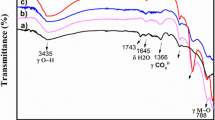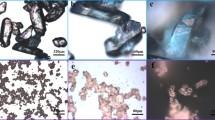Abstract
The kinetics of oxidation of acetoacetanilide by potassium hexacyanoferrate(III) at a constant ionic strength of 0.5 mol dm−3 in aqueous alkaline medium has been studied successfully. The reaction follows less than unit order kinetics with respect to acetoacetanilide and hydroxide ion concentrations. The effect of dielectric constant and ionic strength was investigated. Activation parameters with respect to slow step were determined and discussed. Thermodynamic quantities were also determined. The final product of the reaction has been recognised as a dimer with the evidence of LCMS, UV–Vis, and IR spectra. Based on the experimental results and product analysis a mechanism involving free radicals was proposed.
Graphic abstract








Similar content being viewed by others
References
Koleske JV (2012) Paint and coating testing manual. Gardener-Sward Handbook, 14th edn. ASTM International, West Conshohocken, p 198
Hunger K, Herbst W (2012) Pigments, organic in Ullmann’s encyclopedia of industrial chemistry. Willey-VCH, Weinheim
Dong JH, Qiu KY, Feng XD (1994) Macromol Chem Phys 195:823
Priya NP, Firdous AP, Jeevana R, Aravindakshan KK (2015) Indian J Pharm Sci 77:655
Audeh CA, Smith JRL (1970) J Chem Soc (B):1280
Rao VS, Sethuran B, Rao TN (1979) Indian J Chem 17A:260
Ball S, Bruice T (1980) J Am Chem Soc 102:6498
Shimpia R, Fadata R, Janraob DM, Farooquic M (2014) J Chem Pharm Res 6:1011
Singh MP, Ghosh S (1957) Z Phys Chem (Leipzig) 207:187
Sharma VK (2002) Adv Environ Res (Oxford, UK) 6:143
Laviron E (1979) J Electroanal Chem 101:19
Bard AJ, Faulkner LR (2004) Electrochemical methods fundamentals and applications, 2nd edn. Wiley, Hoboken, p 236
Zaleska B, Lis S (2001) Synth Commun 31:189
Singh MP, Ghosh S (1955) Z Phys Chem (Leipzig) 204:1
Fiegl F (1975) Spot tests in organic analysis. Elsevier, New York, p 212
Singh MP, Ghosh S (1957) Z Phys Chem (Leipzig) 207:187
Singh MP, Ghosh S (1957) Z Phys Chem (Leipzig) 207:198
Wiberg KB, Nigh WG (1965) J Am Chem Soc 87:3849
Kochi JK, Graybill BM, Kwiz M (1964) J Am Chem Soc 86:5257
Cho LY, Romero JR (1995) Tetrahedron Lett 36:8757
Laloo D, Mahanti MK (1986) Pol J Chem 60:589
Panigrahi GP, Misro PK (1977) Indian J Chem 15A:1066
Harihar AL, Kembhavi MR, Nandibewoor ST (2000) Monatsh Chem 131:739
Goel A, Sharma R (2012) J Chem Eng and Mat Sci 3:1
Baciocchi E, Ruzzlconi R (1989) In: Minisci F (ed), Free radicals in synthesis and biology. Kluwer Academic Publisher Series C: Mathematical and Physical Sciences, vol 260, p 155
Pauling L (1969) In the nature of the chemical bond, 3rd edn. Oxford and IBH publishers, New Delhi
Pattar V, Magdum P, Patil D, Nandibewoor ST (2016) J Chem Sci 128:477
Farokhi SA, Nandibewoor ST (2003) Tetrahedron 59:7595
Vogel AI (1951) Quantitative inorganic analysis, 2nd edn. Woolwich Polytechnic, London, p 242
Acknowledgements
The authors gratefully acknowledge the financial support from the UGC, New Delhi by awarding UGC-BSR Faculty Fellowship to Dr. S. T. Nandibewoor and UGC-BSR Fellowship to J. T. Bagalkoti.
Author information
Authors and Affiliations
Corresponding author
Additional information
Publisher's Note
Springer Nature remains neutral with regard to jurisdictional claims in published maps and institutional affiliations.
Electronic supplementary material
Below is the link to the electronic supplementary material.
Appendix
Appendix
From Scheme 2,
From the Law of mass action, second equilibrium constant is given by
This can be rearranged as
Equation (7) takes the form upon substituting the [C] from Eq. (8)
The first equilibrium constant is given by
This can be rearranged as
The total concentration of ACTN is given
The total concentration of OH− is given by
Because of low concentrations of Fe(CN)63−, ACTN used
The total concentration of Fe(CN)63− is given by
Substituting the value of (12) (13), and (14) in (11) and omitting subscripts T and f
Since [Fe(CN)63−] < < 1 above equation becomes
Neglecting square terms in view of low value as compared to unity, hence Eq. (15) becomes
Rights and permissions
About this article
Cite this article
Bagalkoti, J., Nandibewoor, S.T. Investigation of kinetics and mechanism of oxidation of acetoacetanilide in alkaline medium using hexacyanoferrate(III). Monatsh Chem 150, 1469–1478 (2019). https://doi.org/10.1007/s00706-019-02482-8
Received:
Revised:
Accepted:
Published:
Issue Date:
DOI: https://doi.org/10.1007/s00706-019-02482-8




